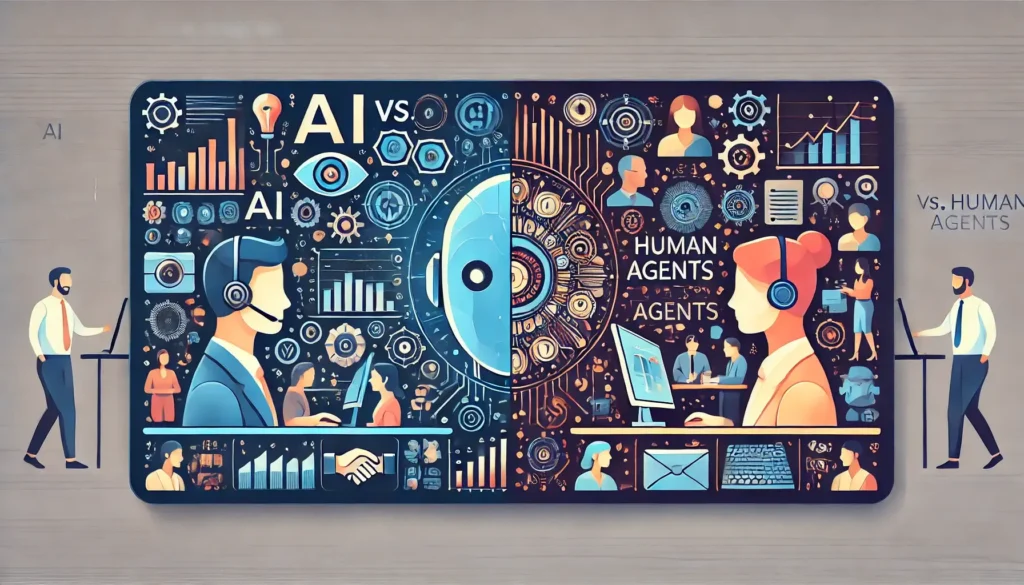Ultimate Guide: AI vs Human Agents – 7 Essential Strategies for Your Business

When evaluating AI vs human agents for customer service, businesses face a critical decision that impacts their operational efficiency and customer satisfaction. The strategic implementation of both AI and human agents has become essential for companies seeking to optimize their customer service operations while managing costs effectively.
Table of Contents
- Understanding AI vs Human Agents: Key Differences
- The Evolution of Customer Service Technology
- AI vs Human Agents: Cost Comparison Analysis
- Implementation Strategies
- Optimizing AI vs Human Agents for Customer Service
- Future Trends and Considerations
- Conclusion
Understanding AI vs Human Agents: Key Differences
According to McKinsey & Company’s latest research, the comparison between AI vs human agents reveals distinct advantages for each approach. While AI excels at handling routine tasks, human agents bring irreplaceable emotional intelligence to complex interactions.
Learn more about implementing these solutions in our detailed AI implementation guide.
AI Agent Capabilities
- 24/7 availability
- Instant response times
- Consistent service delivery
- Multi-query handling
- Cost-effective scaling
Human Agent Strengths
- Emotional intelligence
- Complex problem-solving
- Creative solutions
- Relationship building
- Nuanced communication
The Evolution of Customer Service Technology
The Harvard Business Review highlights how AI vs human agents comparison has evolved over the years. Today’s successful businesses don’t choose between one or the other – they create a hybrid approach that maximizes the strengths of both.
Check out our customer service automation guide for practical implementation tips.
AI vs Human Agents: Cost Comparison Analysis
When analyzing AI vs human agents from a cost perspective, several factors come into play:
- Initial Investment
- AI implementation costs
- Training expenses
- Infrastructure requirements
- Read our complete cost analysis guide for detailed breakdowns
- Ongoing Expenses
- Maintenance costs
- Updates and upgrades
- Training and development
- Resource allocation
According to Gartner’s research, businesses implementing a balanced approach of AI vs human agents see an average cost reduction of 30%.
Optimizing AI vs Human Agents for Customer Service
The key to successful customer service lies in finding the perfect balance between AI vs human agents. Here’s how to optimize both:
AI Optimization
- Automated routing
- Pattern recognition
- Data analysis
- Quick resolution paths
- Learn more in our AI optimization guide
Human Agent Enhancement
- Specialized training
- Tool integration
- Performance metrics
- Continuous improvement
- Discover best practices in our agent training guide
Implementation Strategies
Successful implementation of AI vs human agents requires a structured approach:
- Assessment Phase
- Current capabilities
- Customer needs
- Resource availability
- Budget constraints
- Integration Phase
- System setup
- Team training
- Process alignment
- Performance monitoring
- Optimization Phase
- Data analysis
- Process refinement
- Continuous improvement
- Regular updates
Future Trends and Considerations
The landscape of AI vs human agents continues to evolve. Recent studies from IBM Research indicate that hybrid models will become increasingly sophisticated, offering new opportunities for business optimization.
Explore upcoming trends in our future of customer service article.
Conclusion
The debate between AI vs human agents isn’t about choosing one over the other – it’s about finding the right balance for your specific business needs. By carefully considering the factors we’ve discussed and implementing a strategic approach, you can create a customer service operation that leverages the best of both worlds.
Want to learn more? Check out our complete customer service guide for additional insights and strategies.
